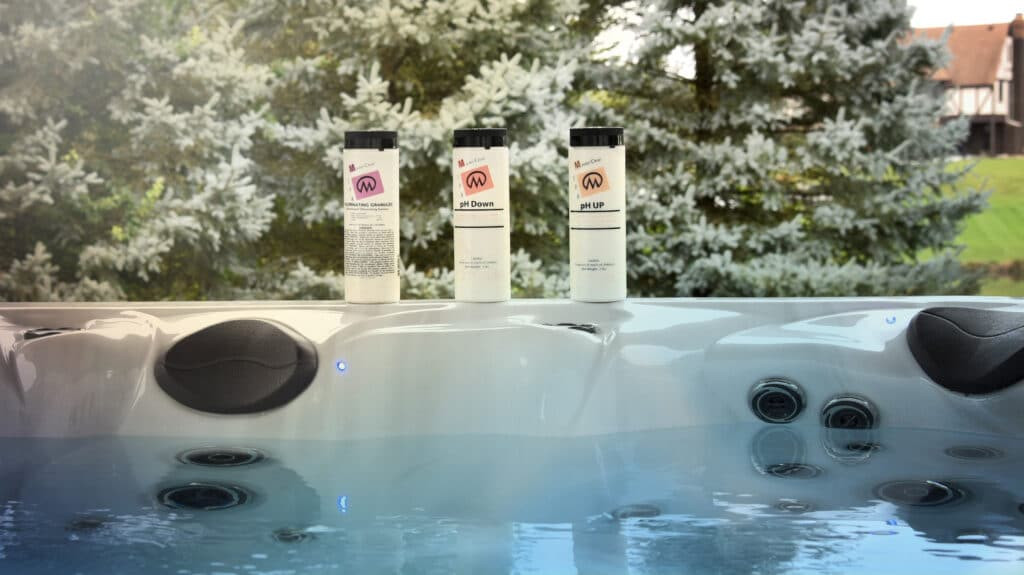Cloudy Spa Water can definitely put a damper on your relaxation, but don’t worry, spa-wear.com is here to help you get your spa back to crystal clear. Discover effective solutions and preventative measures to maintain pristine water quality. Plus, explore our selection of spa wear designed for ultimate comfort and hygiene, enhancing your spa experience with spa-wear.com. Get ready to dive into clear water with products promoting sanitation, cleanliness, and overall well-being.
1. What Causes Cloudy Spa Water?
Cloudy spa water is a common frustration for spa owners, but understanding the root causes can help you address the issue effectively. Typically, it stems from a combination of factors that disrupt the water’s delicate balance. The primary culprits often include imbalances in water chemistry, accumulation of contaminants, and inadequate filtration.
Several elements can contribute to this problem:
- Imbalanced Water Chemistry: Maintaining the correct pH, alkalinity, and sanitizer levels is crucial for water clarity.
- High pH and Alkalinity: Elevated pH and alkalinity levels can lead to cloudiness by causing minerals to precipitate out of the water. When alkalinity levels exceed the recommended range of 80-150 ppm, the water’s stability is compromised, inhibiting bacteria growth and resulting in a cloudy appearance.
- Low Sanitizer Levels: Insufficient chlorine or bromine allows bacteria and organic matter to thrive, leading to cloudy water.
- Contaminant Buildup: Body oils, lotions, soaps, and other organic materials introduced by spa users can overwhelm the sanitizing system.
- Poor Filtration: A dirty or malfunctioning filter cannot effectively remove particles, leading to cloudiness.
- Old Water: Over time, spa water accumulates dissolved solids that can contribute to cloudiness, even with proper chemical balance.
Understanding these common causes is the first step in restoring your spa water to its clear and inviting state. Regular testing and maintenance are key to preventing cloudy water and ensuring a pleasant spa experience.
2. Identifying the Key Culprits Behind Murky Spa Water
To effectively combat cloudy spa water, it’s essential to pinpoint the exact causes. Several common factors can contribute to this issue, each requiring a specific approach to resolve.
2.1 Chemical Imbalance: pH and Alkalinity
Maintaining proper chemical balance is paramount for clear spa water. pH and alkalinity play significant roles in water clarity and overall spa health.
- High pH Levels: When the pH level is too high (above 7.6), it can lead to various problems, including cloudy water, scale buildup, and reduced sanitizer effectiveness. High pH causes minerals to precipitate out of the water, creating a cloudy appearance.
- High Alkalinity Levels: Alkalinity refers to the concentration of alkaline substances in the water, such as carbonates and bicarbonates. When alkalinity is too high (above 150 ppm), it can cause similar issues as high pH, including cloudy water and scale formation. Maintaining alkalinity within the ideal range of 80-150 ppm is crucial for preventing cloudiness.
- According to the Pool & Hot Tub Alliance (PHTA), balanced alkalinity helps stabilize pH levels, preventing drastic fluctuations that can lead to water quality issues.
2.2 Insufficient Sanitizer: Chlorine and Bromine
Sanitizers like chlorine and bromine are essential for killing bacteria and other microorganisms that can cloud spa water.
- Low Sanitizer Levels: When sanitizer levels are too low, bacteria and algae can thrive, leading to cloudy and potentially unsafe water. Regularly test your water to ensure chlorine levels are between 1-3 ppm or bromine levels are between 3-5 ppm.
- The Centers for Disease Control and Prevention (CDC) recommends maintaining proper sanitizer levels to prevent the spread of germs and ensure a safe spa experience.
2.3 Introduction of Contaminants: Body Oils and Lotions
Personal care products like body oils, lotions, and soaps can introduce contaminants into the spa water, contributing to cloudiness.
- Body Care Products: These products contain organic compounds that can react with sanitizers, reducing their effectiveness and leading to cloudy water. Encourage spa users to shower before entering the spa to minimize the introduction of contaminants.
- A study published in the Journal of Environmental Health found that pre-showering significantly reduces the amount of organic matter introduced into recreational water facilities, improving water quality.
2.4 Filter Issues: Clogged or Old Filters
The spa filter is responsible for removing particulate matter from the water, and a clogged or old filter can lead to cloudiness.
- Dirty Filters: Over time, filters become clogged with dirt, debris, and organic matter, reducing their ability to effectively filter the water. Clean your filter regularly according to the manufacturer’s instructions, and replace it every 12-18 months.
- According to filter manufacturer Pleatco, regular filter cleaning and replacement can significantly improve water clarity and reduce the need for chemical treatments.
2.5 Overuse of Defoamer
While defoamer can temporarily reduce foam in spa water, overuse can actually contribute to cloudiness.
- Excessive Defoamer Use: Defoamer contains ingredients that can cloud the water if used in excess. Use defoamer sparingly and only when necessary to control foam.
2.6 Old Spa Water
Over time, spa water accumulates dissolved solids and other impurities that can make it difficult to maintain clarity.
- Water Saturation: Even with proper chemical balance and filtration, old spa water can become saturated with dissolved solids, leading to cloudiness. Drain and refill your spa every 3-6 months to refresh the water.
- The International Spa Association (ISPA) recommends regular water changes to maintain optimal water quality and prevent the buildup of harmful substances.
By identifying the specific factors contributing to cloudy spa water, you can take targeted steps to restore clarity and enjoy a pristine spa experience. Spa-wear.com offers a range of products and resources to help you maintain your spa’s water quality, including test strips, sanitizers, and filter cleaners.
3. Step-by-Step Guide to Clearing Cloudy Spa Water
Once you’ve identified the likely cause of your cloudy spa water, it’s time to take action. Follow these steps to restore clarity and enjoy your spa again.
3.1 Test and Balance Water Chemistry
The first step in clearing cloudy spa water is to test and balance the water chemistry. Use a reliable test kit or test strips to measure the pH, alkalinity, and sanitizer levels in your spa water.
- Adjust pH: The ideal pH range for spa water is 7.2-7.6. If your pH is too high, add a pH decreaser (sodium bisulfate) according to the product instructions. If your pH is too low, add a pH increaser (sodium carbonate).
- Adjust Alkalinity: The ideal alkalinity range is 80-150 ppm. If your alkalinity is too high, add a pH decreaser, which will also lower alkalinity. If your alkalinity is too low, add an alkalinity increaser (sodium bicarbonate).
- Sanitize: Ensure your sanitizer levels are within the recommended range. Add chlorine or bromine as needed to achieve a chlorine level of 1-3 ppm or a bromine level of 3-5 ppm.
- Remember to always follow the manufacturer’s instructions when adding chemicals to your spa water.
3.2 Shock the Water
After balancing the water chemistry, shock the water to kill any remaining bacteria and organic matter.
- Add Non-Chlorine Shock: Use a non-chlorine shock treatment (potassium monopersulfate) according to the product instructions. This will oxidize contaminants and help clear the water.
- Run Circulation System: Turn on your spa’s circulation system and let it run for at least 30 minutes to distribute the shock treatment throughout the water.
3.3 Clean or Replace the Filter
A dirty filter can contribute to cloudy water, so it’s important to clean or replace it.
- Remove Filter: Turn off the spa and remove the filter housing.
- Clean Filter: Rinse the filter with a garden hose to remove loose debris. For a more thorough cleaning, soak the filter in a filter cleaner solution according to the product instructions.
- Replace Filter: If the filter is old or damaged, replace it with a new one.
3.4 Use a Water Clarifier
A water clarifier can help coagulate small particles in the water, making them easier for the filter to remove.
- Add Clarifier: Add a spa water clarifier according to the product instructions.
- Run Circulation System: Turn on your spa’s circulation system and let it run for at least 8 hours to allow the clarifier to work.
3.5 Drain and Refill (If Necessary)
If the water is still cloudy after following these steps, it may be necessary to drain and refill the spa.
- Drain Spa: Turn off the spa and drain the water completely.
- Clean Spa Shell: Use a spa cleaner to clean the spa shell and remove any buildup or stains.
- Refill Spa: Refill the spa with fresh water, using a hose filter to remove impurities from the water source.
- Balance Water Chemistry: Test and balance the water chemistry as described in Step 1.
By following these steps, you can effectively clear cloudy spa water and restore your spa to its pristine condition. Spa-wear.com offers a variety of products to help you maintain your spa’s water quality, including test kits, sanitizers, filter cleaners, and water clarifiers.
4. Preventing Cloudy Spa Water: Proactive Measures
Preventing cloudy spa water is much easier than fixing it. By implementing a few proactive measures, you can keep your spa water crystal clear and enjoy a hassle-free spa experience.
4.1 Regular Water Testing and Balancing
Regularly test and balance your spa water to maintain proper chemical levels.
- Test Frequency: Test your water at least twice a week, or more frequently if you use the spa often.
- Chemical Adjustment: Adjust pH, alkalinity, and sanitizer levels as needed to keep them within the recommended ranges.
4.2 Shower Before Entering the Spa
Encourage spa users to shower before entering the spa to remove body oils, lotions, and other contaminants.
- Pre-Spa Rinse: A quick rinse with soap and water can significantly reduce the amount of contaminants introduced into the spa water.
4.3 Regular Filter Cleaning and Replacement
Keep your filter clean and replace it when necessary to ensure effective filtration.
- Cleaning Frequency: Rinse the filter with a garden hose every 2-4 weeks.
- Deep Cleaning: Soak the filter in a filter cleaner solution every 3-6 months.
- Replacement: Replace the filter every 12-18 months, or sooner if it shows signs of wear or damage.
4.4 Proper Sanitization
Maintain proper sanitizer levels to kill bacteria and prevent algae growth.
- Sanitizer Type: Use chlorine, bromine, or another approved sanitizer according to the manufacturer’s instructions.
- Sanitizer Level: Maintain a chlorine level of 1-3 ppm or a bromine level of 3-5 ppm.
4.5 Limited Use of Defoamer
Use defoamer sparingly and only when necessary to control foam.
- Alternative Solutions: Address the underlying cause of foam, such as high levels of organic matter, instead of relying solely on defoamer.
4.6 Regular Water Changes
Drain and refill your spa every 3-6 months to refresh the water and remove accumulated dissolved solids.
- Water Source: Use a hose filter when refilling the spa to remove impurities from the water source.
4.7 Spa Cover Maintenance
Keep your spa cover clean and in good condition to prevent contaminants from entering the water.
- Cleaning: Clean the spa cover regularly with a mild soap and water solution.
- Protection: Protect the cover from sun damage and extreme weather conditions.
By following these proactive measures, you can prevent cloudy spa water and enjoy a clean, clear, and inviting spa experience. Spa-wear.com offers a range of products to help you maintain your spa’s water quality, including test kits, sanitizers, filter cleaners, water clarifiers, and spa cover protectants.
5. The Role of Spa Wear in Maintaining Water Quality
The clothing you wear in your spa can also impact water quality. Traditional swimwear can carry detergents, dyes, and other contaminants that contribute to cloudiness. Opting for spa-specific wear can minimize these issues.
5.1 Benefits of Spa-Specific Attire
Spa wear, like that offered at spa-wear.com, is designed with materials that are less likely to leach chemicals into the water.
- Material Matters: Look for fabrics that are chlorine-resistant and free of dyes and finishes that can cloud the water.
- Hygiene: Clean spa wear reduces the transfer of body oils, lotions, and other substances into the spa.
5.2 Choosing the Right Spa Wear
Consider these factors when selecting spa attire:
- Fabric: Choose fabrics like organic cotton, bamboo, or microfiber, which are gentle on the skin and less likely to release contaminants.
- Fit: Opt for loose-fitting garments that allow for comfortable movement and relaxation.
- Coverage: Select attire that provides adequate coverage while minimizing the amount of skin exposed to the water.
5.3 Maintaining Your Spa Wear
Proper care of your spa wear will extend its life and help maintain water quality.
- Washing: Wash spa wear after each use with a mild detergent and avoid using fabric softeners, which can leave residue on the fabric.
- Drying: Air-dry spa wear to prevent damage to the fabric and reduce the risk of shrinkage.
- Storage: Store spa wear in a clean, dry place to prevent mold and mildew growth.
By choosing the right spa wear and maintaining it properly, you can minimize the introduction of contaminants into your spa water and help keep it clear and inviting. Spa-wear.com offers a variety of stylish and functional spa wear options designed to enhance your spa experience.
6. Addressing Common Misconceptions About Spa Water Clarity
There are several common misconceptions about spa water clarity that can lead to ineffective or even harmful practices. It’s important to debunk these myths and understand the facts to maintain a healthy and enjoyable spa environment.
6.1 Misconception: Cloudy Water Means the Spa is Unsafe
While cloudy water can indicate a problem, it doesn’t necessarily mean the spa is unsafe.
- Water Testing: Always test the water to determine the cause of the cloudiness and whether it poses a health risk.
- Sanitizer Levels: If sanitizer levels are within the recommended range, the water is likely safe for use, even if it’s cloudy.
6.2 Misconception: More Chemicals Are Always Better
Adding more chemicals than necessary can actually worsen water quality and create health problems.
- Chemical Balance: Focus on maintaining proper chemical balance rather than simply adding more chemicals.
- Product Instructions: Always follow the manufacturer’s instructions when adding chemicals to your spa water.
6.3 Misconception: Draining and Refilling Solves Everything
While draining and refilling can help, it’s not always necessary and can waste water.
- Targeted Solutions: Address the specific cause of the problem rather than automatically draining and refilling the spa.
- Water Conservation: Consider alternative solutions, such as shocking the water or cleaning the filter, before resorting to draining and refilling.
6.4 Misconception: Natural or “Chemical-Free” Spas Don’t Need Maintenance
Even natural or “chemical-free” spas require regular maintenance to prevent bacteria growth and maintain water quality.
- Alternative Sanitizers: Natural spas may use alternative sanitizers, such as ozone or UV systems, but these still require monitoring and maintenance.
- Water Balance: Maintaining proper pH and alkalinity is still important in natural spas.
6.5 Misconception: You Can Judge Water Quality by Appearance
While cloudy water is a sign of a potential problem, clear water doesn’t always mean the spa is safe and healthy.
- Hidden Issues: Water can appear clear but still contain harmful bacteria or other contaminants.
- Regular Testing: Always test the water regularly, regardless of its appearance, to ensure it meets safety standards.
By understanding these common misconceptions, you can make informed decisions about spa maintenance and avoid practices that could harm your water quality or your health. Spa-wear.com provides accurate information and reliable products to help you maintain a safe and enjoyable spa experience.
7. Advanced Techniques for Persistent Cloudy Water
If you’ve tried the standard methods for clearing cloudy spa water and are still struggling, it may be time to consider some advanced techniques. These methods can address more stubborn issues and restore your spa to its pristine condition.
7.1 Enzyme Treatments
Enzyme treatments can break down organic contaminants that contribute to cloudiness.
- Enzyme Products: Add an enzyme product to your spa water according to the manufacturer’s instructions.
- Circulation: Run the circulation system for at least 24 hours to allow the enzymes to work.
7.2 Phosphate Removers
High phosphate levels can interfere with sanitizer effectiveness and contribute to cloudiness.
- Phosphate Testing: Test your water for phosphate levels using a phosphate test kit.
- Phosphate Remover Products: If phosphate levels are high, add a phosphate remover product according to the manufacturer’s instructions.
7.3 Spa Purge Products
Spa purge products can remove biofilm and other buildup from your spa’s plumbing system.
- Purge Treatment: Add a spa purge product to your spa water according to the manufacturer’s instructions.
- Circulation: Run the circulation system for the recommended time period.
- Drain and Refill: Drain and refill the spa after the purge treatment.
7.4 Professional Water Testing
If you’re unable to identify the cause of your cloudy water, consider having your water professionally tested.
- Local Spa Stores: Many local spa stores offer water testing services.
- Detailed Analysis: Professional water testing can provide a detailed analysis of your water’s chemistry and identify any underlying issues.
7.5 Ozone or UV Sanitizing Systems
Consider installing an ozone or UV sanitizing system to supplement your primary sanitizer.
- Ozone Systems: Ozone systems generate ozone gas, which is a powerful oxidizer that kills bacteria and other contaminants.
- UV Systems: UV systems use ultraviolet light to kill bacteria and other microorganisms.
By exploring these advanced techniques, you can tackle persistent cloudy water issues and maintain a clean, clear, and healthy spa environment. Spa-wear.com offers a range of products and resources to help you maintain your spa’s water quality, including enzyme treatments, phosphate removers, spa purge products, and information on ozone and UV sanitizing systems.
8. How Spa-Wear.com Can Help You Maintain Pristine Spa Water
At spa-wear.com, we understand the importance of maintaining pristine spa water for a relaxing and enjoyable experience. That’s why we offer a range of products and resources to help you keep your spa water clean, clear, and healthy.
8.1 High-Quality Spa Wear
Our spa wear is designed with materials that are less likely to leach chemicals into the water, helping to minimize contamination and maintain water quality.
- Chlorine-Resistant Fabrics: Our spa wear is made from chlorine-resistant fabrics that won’t break down or release dyes into the water.
- Gentle Materials: We use gentle, skin-friendly materials that are less likely to cause irritation or introduce contaminants into the spa.
8.2 Expert Advice and Resources
We provide expert advice and resources on spa water maintenance to help you keep your spa water in top condition.
- Informative Articles: Our website features informative articles on spa water chemistry, troubleshooting cloudy water, and other important topics.
- Product Recommendations: We offer personalized product recommendations based on your specific spa needs.
8.3 Convenient Online Shopping
Our convenient online store makes it easy to find and purchase the products you need to maintain your spa water.
- Wide Selection: We offer a wide selection of spa chemicals, filters, cleaners, and other products.
- Fast Shipping: We offer fast shipping to get your products to you quickly and conveniently.
8.4 Customer Support
Our friendly and knowledgeable customer support team is available to answer your questions and provide assistance with your spa water maintenance needs.
- Email Support: Contact us via email for prompt and helpful assistance.
- Phone Support: Call us during business hours for immediate support.
By choosing spa-wear.com, you can ensure that you have the products, resources, and support you need to maintain pristine spa water and enjoy a relaxing and healthy spa experience.
9. Expert Tips for Long-Term Spa Water Management
Maintaining crystal-clear spa water over the long term requires a consistent and proactive approach. Here are some expert tips to help you manage your spa water effectively and prevent common problems.
9.1 Create a Maintenance Schedule
Develop a regular maintenance schedule to ensure that you consistently address important tasks.
- Daily: Check sanitizer levels and adjust as needed.
- Weekly: Test and balance pH and alkalinity.
- Monthly: Clean the filter.
- Quarterly: Drain and refill the spa.
9.2 Keep a Spa Log
Keep a log of your spa’s water chemistry readings and maintenance activities to track trends and identify potential problems early.
- Record Readings: Record pH, alkalinity, sanitizer levels, and other important readings.
- Track Activities: Note when you add chemicals, clean the filter, or drain and refill the spa.
9.3 Invest in Quality Products
Invest in high-quality spa chemicals, filters, and other products to ensure optimal performance and longevity.
- Reputable Brands: Choose products from reputable brands that are known for their quality and effectiveness.
- Proper Storage: Store chemicals in a cool, dry place away from direct sunlight.
9.4 Educate Spa Users
Educate spa users about the importance of showering before entering the spa and avoiding the use of lotions and other products that can contaminate the water.
- Clear Communication: Post signs or provide written instructions to spa users.
- Lead by Example: Follow the same guidelines yourself to set a good example.
9.5 Monitor Water Usage
Monitor your spa’s water usage to detect potential leaks or other problems.
- Check Water Level: Regularly check the water level in the spa to ensure it’s consistent.
- Inspect Equipment: Inspect the spa’s equipment for leaks or other signs of damage.
9.6 Stay Informed
Stay informed about the latest spa water maintenance techniques and products by reading industry publications, attending workshops, or consulting with a spa professional.
- Online Resources: Explore online resources, such as spa forums and blogs, to learn from other spa owners.
- Professional Advice: Consult with a spa professional for personalized advice and recommendations.
By following these expert tips, you can effectively manage your spa water over the long term and enjoy a clean, clear, and healthy spa experience for years to come. Spa-wear.com is committed to providing you with the products, resources, and support you need to achieve your spa water maintenance goals.
10. Frequently Asked Questions About Cloudy Spa Water
Here are some frequently asked questions about cloudy spa water, along with detailed answers to help you troubleshoot and maintain your spa.
Q1: How do I know if my spa water is cloudy?
A1: Cloudy spa water appears hazy or milky, making it difficult to see the bottom of the spa or the jets.
Q2: What are the most common causes of cloudy spa water?
A2: The most common causes include imbalanced water chemistry (high pH or alkalinity, low sanitizer levels), buildup of contaminants (body oils, lotions), and poor filtration (dirty or old filters).
Q3: How often should I test my spa water?
A3: You should test your spa water at least twice a week, or more frequently if you use the spa often.
Q4: What is the ideal pH range for spa water?
A4: The ideal pH range for spa water is 7.2-7.6.
Q5: What is the ideal alkalinity range for spa water?
A5: The ideal alkalinity range for spa water is 80-150 ppm.
Q6: How often should I clean my spa filter?
A6: You should rinse your spa filter with a garden hose every 2-4 weeks and soak it in a filter cleaner solution every 3-6 months.
Q7: How often should I replace my spa filter?
A7: You should replace your spa filter every 12-18 months, or sooner if it shows signs of wear or damage.
Q8: What is a spa water clarifier and how does it work?
A8: A spa water clarifier is a chemical that helps coagulate small particles in the water, making them easier for the filter to remove.
Q9: How often should I drain and refill my spa?
A9: You should drain and refill your spa every 3-6 months, or sooner if the water becomes difficult to manage.
Q10: Can I use my spa if the water is cloudy?
A10: It’s generally not recommended to use your spa if the water is cloudy, as it may indicate a health risk. Test the water to determine the cause of the cloudiness and address the problem before using the spa.
By understanding these frequently asked questions, you can better troubleshoot and maintain your spa water, ensuring a clean, clear, and healthy spa experience. Spa-wear.com is here to provide you with the products, resources, and support you need to achieve your spa water maintenance goals.
Ready to enjoy crystal-clear spa water and the ultimate relaxation experience? Visit spa-wear.com today to explore our selection of high-quality spa wear, water maintenance products, and expert resources. Contact us at +1 (480) 947-5400 or visit our Scottsdale location at 7014 E Camelback Rd, Scottsdale, AZ 85251, United States. Let spa-wear.com help you create the perfect spa oasis in your own backyard.






